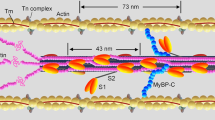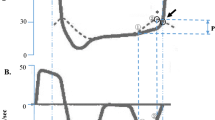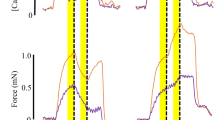Abstract
RESTING frog skeletal muscle, when stretched at a constant velocity, exhibits a force response which, for length changes less than about 0.2%, is elastic in nature. First observed by Hill1, this response was attributed to a short range elastic component (SREC) that was thought to be a property of a small number of cross bridges which, even in the resting state, extend from the myosin-containing thick filaments to interact with sites on the actin-containing thin filaments. This view was criticised2 on the grounds that the SREC stiffness remained approximately constant as the amount of thick and thin filament overlap was decreased by increasing muscle length. On the basis of the sliding filament theory3,4, SREC stiffness would be expected to decrease because reduced amounts of thick and thin filament overlap would result in a decreased number of cross bridges available in interact with thin filament sites. Flitney and Hirst5 have reported that in twitch contractions of frog skeletal muscle a short range elastic response is present and is similar in form to that of resting muscle. In this case, however, a directly proportional relationship was found between the short range stiffness and the amount of overlap between the thick and thin filaments, which suggests that this stiffness is a property of attached cross bridges. To investigate the possible presence of attached cross bridges in resting muscle, we have measured the calcium dependence of the short range stiffness in skeletal and cardiac muscle preparations in which the myofibrils were directly exposed to the bathing medium.
This is a preview of subscription content, access via your institution
Access options
Subscribe to this journal
Receive 51 print issues and online access
$199.00 per year
only $3.90 per issue
Buy this article
- Purchase on Springer Link
- Instant access to full article PDF
Prices may be subject to local taxes which are calculated during checkout
Similar content being viewed by others
References
Hill, D. K., J. Physiol. Lond., 199, 637–684 (1968).
Sandow, A., A. Rev. Physiol., 32, 87–138 (1970).
Huxley, A. F., J. Physiol., 243, 1–43 (1974).
Huxley, H. E., Proc. R. Soc., B 178, 131–149 (1971).
Flitney, F. W., and Hirst, D. G., J. Physiol. Lond., 239, 119P (1974).
Julian, F. J., J. Physiol. Lond., 218, 117–145 (1971).
Lannergren, J., J. gen. Physiol., 58, 145–162 (1971).
Endo, M., Proc. Jap. Acad., 51, 467–472 (1975).
Ebashi, S., and Endo, M., Prog. Biophys. molec. Biol., 18, 123–183 (1968).
Haselgrove, J. C., J. molec. Biol., 92, 113–143 (1975).
Matsubara, I., and Millman, B. M., J. molec. Biol., 82, 527–536 (1974).
Author information
Authors and Affiliations
Rights and permissions
About this article
Cite this article
MOSS, R., SOLLINS, M. & JULIAN, F. Calcium activation produces a characteristic response to stretch in both skeletal and cardiac muscle. Nature 260, 619–621 (1976). https://doi.org/10.1038/260619a0
Received:
Accepted:
Issue Date:
DOI: https://doi.org/10.1038/260619a0
This article is cited by
-
Muscle thixotropy as a tool in the study of proprioception
Experimental Brain Research (2014)
-
Current problems in smooth muscle mechanics
Experientia (1985)
-
Free calcium in heart muscle at rest and during contraction measured with Ca2+-sensitive microelectrodes
Nature (1980)
-
Elastic and inelastic behaviour of resting frog muscle fibres
Pfl�gers Archiv European Journal of Physiology (1980)
Comments
By submitting a comment you agree to abide by our Terms and Community Guidelines. If you find something abusive or that does not comply with our terms or guidelines please flag it as inappropriate.



